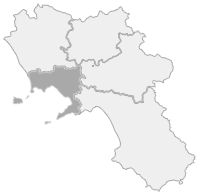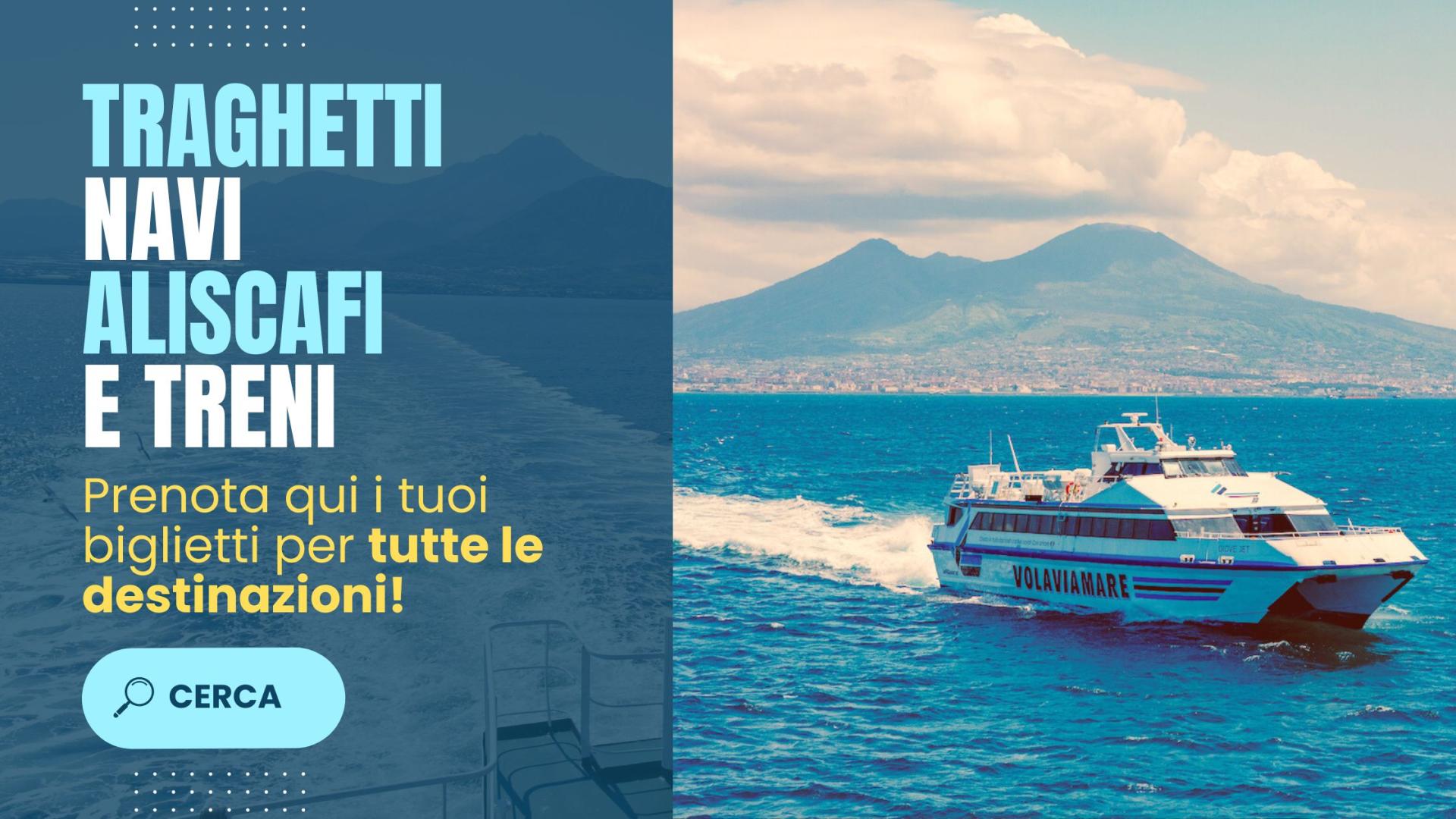A green crescent in the intense blue of the sea. This is how Vivara appears from above and from the promontory of Santa Margherita Vecchia, in Procida, at the closest point between the two islands. United by human will today as originally the creative force of the earth had connected them. Because there was a time when Vivara and Procida were one. Fruit of the crater formed 55 thousand years ago in the south-western part of the island, which other volcanic phenomena had already shaped. Subsequent geological events would have isolated that fragment from the large island which, however, retains the imprint of its origin in its conformation. Unequivocal, all the more by observing the continuity of the forms with the Procidan part of the circle of the ancient crater, now occupied by the sea and known as the gulf of Gènito.
Procida is connected to its separate part by the 362-metre-long aqueduct bridge, which reveals its very particular function from the name: to support the water pipeline that brings water from the mainland to Ischia, passing over land to Procida and Vivara. A pedestrian path suspended over the sea, as rich in suggestions as it is prodigal in panoramic views. Until the arrival at Punta Capitello, in the northern part of Vivara. At the end of the bridge you go up a flight of steps, built to accommodate Princess Maria Josè of Savoy, when she wanted to visit the islet in 1930. From there begins the long path that crosses Vivara from Punta Capitello, to the north-east, to Punta Mezzogiorno, on the opposite side, to the southeast.
Covering approximately 35 hectares, with a perimeter of three kilometers and a maximum height of 109 meters, Vivara has rather high coasts and, in various stretches, decidedly steep, so it is not accessible from the sea. Even the ancient sailors who experimented with new routes in the Mediterranean, in search of useful ports of call for navigation and trade, were well aware of this. This territory still connected to Procida by a cliff did not have beaches, but its position with respect to Ischia and in the great gulf was too favorable to give up. And the Mycenaeans in the 16th century BC made it their northernmost port of call in the Tyrrhenian Sea, an integral part of the network of settlements they had already activated in Sicily and the Aeolian Islands.
FROM THE MYCENAES TO THE BOURBONS
It was the archaeologist Giorgio Bucher in 1937 who was the first to identify traces and artifacts of the Minoan presence at Punta Capitello, simultaneously with the findings on the neighboring Ischia, in the Castiglione site. New excavation campaigns, starting in 1976, brought to light three settlements at Punta Capitello to the north, Punta Mezzogiorno to the south and Punta d'Alaca to the west, where is the narrowest point of the Ischia channel and where there it was also a landing possibility. The finds have shown that the Mycenaeans maintained peaceful relations with the natives, with whom there was a fruitful cultural and technical exchange. From that phase imported ceramics have been found, similar to those of Aegean production of the 16th century, objects in local clay worked on the lathe of Mycenaean tradition and metal objects certainly imported, but worked on site. Two centuries later, in the 14th century, the Tyrrhenian ports lost interest for the Mycenaeans, who had moved their area of influence between the Adriatic and the Ionian, so they completely left the Procidan settlements.
Moreover, the environmental resources running out, a very small arable plain and the lack of water veins that characterized the Vivara sites, accelerated the process.
That name, then, Vivara, appeared several centuries later, probably borrowed from the fish farm that the Romans inaugurated in the small gulf of Gènito. From that Vivarium we arrived with successive adaptations to the current toponym. On land, however, the Romans began to use that green offshoot of Procida as a hunting oasis. And it remained so afterwards. It was Alfonso d'Avalos, in the sixteenth century, who introduced various animal species to the islet for hunting purposes, as all subsequent lords continued to do. They frequented Vivara and Procida itself for their hunting trips. The only residential building was built in 1681 by Giovanni de Guevara, from whose name, according to another hypothesis, that of Vivara would have derived. That structure later became a Bourbon hunting lodge. In the Napoleonic period, the islet was used as a military outpost on the sea and the still visible fortifications date back to that time, before it was transferred from military state property to the Municipality in 1818.
This went on until the sixties of the last century, when the activity was interrupted and the islet remained uninhabited. Then began a phase of abandonment, which had a significant impact on the further evolution of the vegetation heritage. This has seen the Mediterranean maquis gradually prevail, with species that have adapted to the different climatic and rainfall situations found between one slope and another. On the cooler and more humid slopes, the high maquis with strawberry trees, which even reach six meters, dominates; heathers, also very tall, which form groves with white blooms, very evident in the month of February; some varieties of honeysuckle, madder and sarsaparilla. On the warmer and more arid slopes, closest to the sea, the lower maquis dominates with mastic, myrtle, phillyrea, buckthorn, broom, euphorbia and cysts, including the cistus creticus with its characteristic pink flowers. Widespread are the patches of wild olive trees, which in the highest part of the island coexist with myrtle, mastic and carob trees. In the clearings, with generally precocious flowering compared to other places, Vivara takes on color thanks to the ferule, the clovers, the viscose inula with beautiful yellow flowers and the expanses of narcissi, which in Procida they call "candelore". And there are several species of wild orchids, especially of the genus Serapias. The presence of originally tropical species such as American agaves, prickly pears, carboprotus is very limited. While concentrated near the ruins there are capers, rosemary, wild jasmine and wild fennel. On the other hand, laurel and ivy are decidedly rare in Vivara.
THE NATURALISTIC OASIS
In 1940 Vivara was privatized. But its environmental value was officially recognized in 1974, when it became a protected naturalistic oasis. After various and complex vicissitudes, due to the commitment of environmental associations, in recent times Vivara, completely uninhabited and declared a State Nature Reserve, was rented by the Region as a place for research and naturalistic observation. Its sea, rich in biodiversity, is part of the Kingdom of Neptune Marine Protected Area.
An area completely covered by thick oak woods. Above all holm oaks and downy oaks. This is how Vivara appeared when it was still an offshoot of Procida and also after having become a land entirely surrounded by the sea. A few spots of that holm oak forest remain on the eastern side, where holm oaks are also accompanied by downy oaks and manna ash. If the ancient inhabitants had already begun to convert some areas to agriculture, large-scale deforestation, which changed the face of the islet, took place around 1830, when the forest was sacrificed for new plantings of vines and olive trees. As many as three thousand olive trees were planted in those years, while new extensions of land were dedicated to other crops. As evidence of the agricultural "mutation" of Vivara, the farmhouse remains in the centre of the islet, right next to the manor house also used by the king during hunting trips. And the cistern, essential for the needs of the very few inhabitants, livestock and crops, considering that Vivara has no water. And then the oil mill, the millstone with a domed roof, the cowshed with the stable and the tower for hunting turtle doves. All artifacts related to the transformation of the main productions, olives and grapes. In addition to vegetables.
Mushrooms of the most varied species are very common in autumn: field mushrooms, small nails, small families, porcini mushrooms, drumsticks and puffballs.
The natural oasis is an ideal reference point for as many as five hundred species of birds. About a hundred are sedentary, others in transit, during both autumn and spring migrations. And in fact Vivara is also a ringing area for migratory birds. There are numerous protected species that nest, such as the peregrine falcon, the scops owl, the barn owl, the nightjar and the Corsican gull. Punta d'Alaca is the realm of the herring gull.
If the amphibians are absent, due to the lack of water, the reptiles are represented by field lizards, geckos, hemidactyls and by a single species of snake, the harmless snake. There are also eleven species of mammals: from rats, wild mice and house mice to rabbits, introduced for hunting since the time of Charles III of Bourbon. Three species of bats are the subject of studies and observations. In 1981 a new species of insect was also discovered, which lives on the roots of innula viscosa, to which the name of Peliococcus vivarensis was given. And there is no shortage of butterflies, attracted by the blooms of which the Mediterranean maquis is prodigal throughout the year: in the foreground, the nymph of the strawberry tree and the Cleopatra butterfly.
For this extraordinary natural heritage, Vivara is SCI, Site of Community Interest, and SPA, Special Protection Area.




Comments powered by CComment